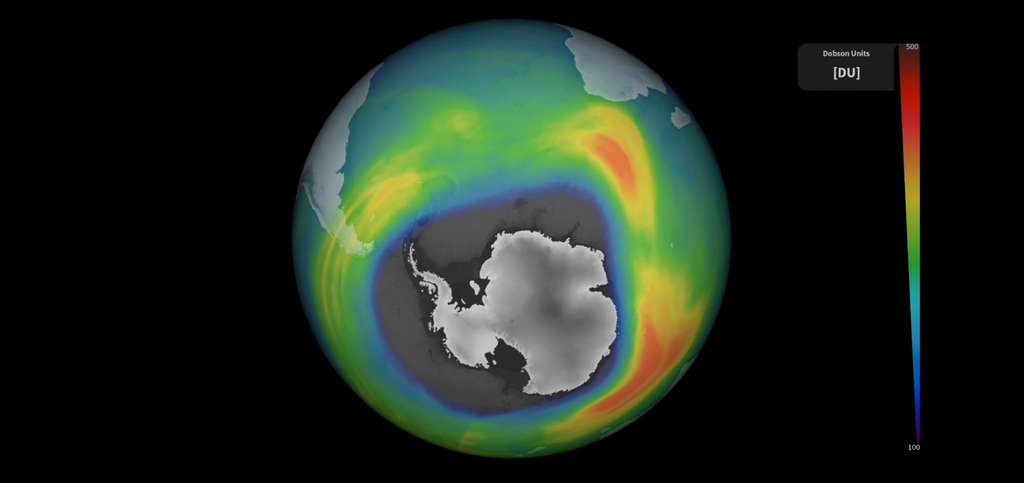
How is the ozone hole measured?
The size of the ozone hole fluctuates periodically. From August to October, the ozone hole increases in size, reaching a maximum between mid-September and mid-October. As stratospheric temperatures begin to rise in the Southern Hemisphere, ozone depletion slows, the polar vortex weakens and eventually collapses, and by the end of December ozone levels return to normal.
Released in October 2017, Copernicus Sentinel-5P (short for Sentinel-5 Precursor) It is the first Copernicus satellite dedicated to observing our atmosphere. It is part of the fleet of Copernicus Sentinel missions being developed by the European Space Agency for the European Union’s Environmental Monitoring Programme.
The satellite carries a Imaging spectrometer Advanced multispectral is called Tropomy. It detects the unique fingerprints of atmospheric gases in different parts of the electromagnetic spectrum to image a wide range of pollutants with greater resolution and higher spatial resolution than ever before.
Tropome Total Ozone Measurements It is processed inside the ground segment of Sentinel-5P at the German Aerospace Center (DLR) using algorithms developed by DLR and the Royal Belgian Institute for Astronautics (BIRA-IASB).

The ozone hole monitored by the German Space Center
The Sentinel-5P total column ozone product is provided within three hours from the time of measurement to the Copernicus Atmosphere Monitoring Service (CAMS). CAMS, implemented by the European Center for Medium-Range Weather Forecasts (ECMWF) on behalf of the European Union, incorporates these near-real-time Sentinel-5P ozone data into its forecasting and data analysis system.
Antje EnnisA senior scientist at CAMS said: “Our operational ozone forecasting and monitoring service shows that the 2023 ozone hole started early and has been increasing rapidly since mid-August. Its size reached more than 26 million square kilometers on September 16, making it one of the largest ozone holes ever recorded.. The Tropome ozone data is an important data set for our ozone analysis“.
Why is the ozone hole so big?
Variation in the size of the ozone hole It is largely determined by the strength of the strong winds that flow around the Antarctic region. This strong wind band is a direct result of the Earth’s rotation and the strong temperature differences between polar and temperate latitudes.
If the wind band is strong, it acts as a barrier: air masses can no longer be exchanged between polar and temperate latitudes. The air masses in the polar latitudes then isolate and cool during the winter.
Water vapor traces from Hunga Tonga volcano
Although it may be too early to discuss the reasons behind current ozone concentrations, some researchers predict that Unusual ozone patterns this year could be linked to the Hunga Tonga-Hunga Haapai volcano eruption in January 2022.

3D representation of the evolution of the ozone hole in 2023
Antje explains: “The eruption of the Hunga Tonga volcano in January 2022 released a large amount of water vapor In the stratosphere, which did not reach the Antarctic regions until after the ozone hole ended in 2022.
“It is possible that water vapor has caused increased formation of polar stratospheric clouds, where chlorofluorocarbons (CFCs) can interact and accelerate ozone depletion. The presence of water vapor may also contribute to the cooling of the Antarctic stratosphere, further enhancing the formation of these Polar stratospheric clumps and results in a stronger polar vortex.“.
However, it is important to note that the precise impact of the Hunga Tonga volcanic eruption on the ozone hole in the Southern Hemisphere It remains the subject of ongoing research.. This is because there are no previous cases of injecting large amounts of water vapor into the stratosphere in modern observations.
The continuing impact of ozone-depleting substances
In the seventies and eighties, Widespread use of CFCs Harmful chemicals found in products such as refrigerators and aerosol cans have damaged the high ozone layer in our atmosphere, causing a hole in the ozone layer over Antarctica.
In response, in 1987 Montreal Protocol To protect the ozone layer by gradually eliminating the production and consumption of these harmful substances, leading to recovery of the ozone layer.
Klaus Zaheer concludes: “Based on the Montreal Protocol and the decline in anthropogenic ozone-depleting substances, scientists currently expect that the global ozone layer will return to normal around 2050.“.

The ozone layer: a whole new world

“Unapologetic tv specialist. Hardcore zombie trailblazer. Infuriatingly humble problem solver.”
